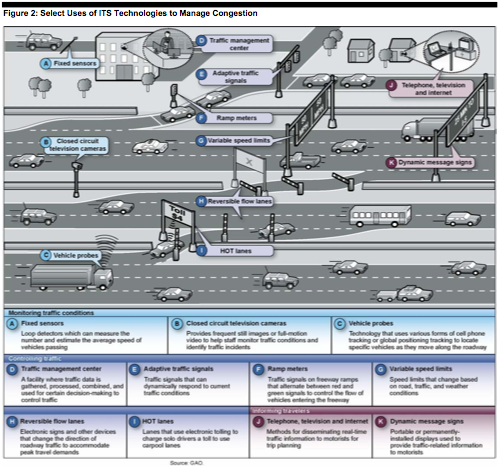Definition[]
An intelligent transportation system (ITS)
| “ | use[s] communications, electronics, sensors, and computer hardware and software to improve the performance or safety of freeway and transit systems that are designed to improve traffic flow.[1] | ” |
Overview[]
An Intelligent Transportation System make transport more efficient, faster, easier and reliable. The focus is on smart solutions to integrate passenger and freight flows across transport modes and provide sustainable solutions to infrastructure bottlenecks affecting roads, railways, sky, sea and waterways. ITS encompasses a broad range of wireless and wireline communications-based information and electronics technologies, such as
- systems that collect real-time traffic data and transmit information to the public via dynamic message signs and other means,
- ramp meters to improve the flow of traffic on freeways, and
- synchronized traffic signals that are adjusted in response to traffic conditions.
When integrated into the transportation system's infrastructure, and in vehicles themselves, these technologies relieve congestion, improve safety and enhance American productivity.
ITS is made up of 16 types of technology-based systems. These systems are divided into intelligent infrastructure systems and intelligent vehicle systems.
Program description[]
Located in the U.S. Department of Transportation’s Research and Innovative Technology Administration (RITA), the Intelligent Transportation Systems (ITS) program researches ways that information and communications technologies can improve surface transportation safety and mobility and contribute to America’s economic growth. ITS applications focus on both the infrastructure and vehicle as well as integrated applications between the two. Familiar ITS technologies include electronic toll collection, in-vehicle navigation systems, rear-end collision avoidance systems and dynamic message signs.
Technology transfer is also a key element of the ITS program. Research findings and evaluations are published online; a National ITS Architecture and Standards program ensures that States and jurisdictions have the framework they need to deploy interoperable ITS systems; and training on the latest ITS applications is developed and delivered by the program.
Figure 2 (below) shows selected uses of ITS technologies:
References[]
Source[]
External resources[]
- ITS Applications Overview Web Site.
- Department of Transportation, “Intelligent Transportation Systems (ITS),” (2015) (full-text).
- Bruce Katz, "Why the U.S. Government Should Embrace Smart Cities" (Brookings Institution) (July 26, 2011) (full-text).
